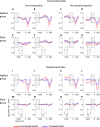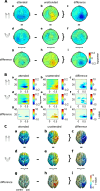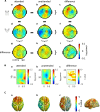Alpha-band oscillations reflect external spatial coding for tactile stimuli in sighted, but not in congenitally blind humans
- PMID: 31239467
- PMCID: PMC6592921
- DOI: 10.1038/s41598-019-45634-w
Alpha-band oscillations reflect external spatial coding for tactile stimuli in sighted, but not in congenitally blind humans
Abstract
We investigated the function of oscillatory alpha-band activity in the neural coding of spatial information during tactile processing. Sighted humans concurrently encode tactile location in skin-based and, after integration with posture, external spatial reference frames, whereas congenitally blind humans preferably use skin-based coding. Accordingly, lateralization of alpha-band activity in parietal regions during attentional orienting in expectance of tactile stimulation reflected external spatial coding in sighted, but skin-based coding in blind humans. Here, we asked whether alpha-band activity plays a similar role in spatial coding for tactile processing, that is, after the stimulus has been received. Sighted and congenitally blind participants were cued to attend to one hand in order to detect rare tactile deviant stimuli at this hand while ignoring tactile deviants at the other hand and tactile standard stimuli at both hands. The reference frames encoded by oscillatory activity during tactile processing were probed by adopting either an uncrossed or crossed hand posture. In sighted participants, attended relative to unattended standard stimuli suppressed the power in the alpha-band over ipsilateral centro-parietal and occipital cortex. Hand crossing attenuated this attentional modulation predominantly over ipsilateral posterior-parietal cortex. In contrast, although contralateral alpha-activity was enhanced for attended versus unattended stimuli in blind participants, no crossing effects were evident in the oscillatory activity of this group. These findings suggest that oscillatory alpha-band activity plays a pivotal role in the neural coding of external spatial information for touch.
Conflict of interest statement
The authors declare no competing interests.
Figures






Similar articles
-
No Evidence for a Role of Spatially Modulated α-Band Activity in Tactile Remapping and Short-Latency, Overt Orienting Behavior.J Neurosci. 2020 Nov 18;40(47):9088-9102. doi: 10.1523/JNEUROSCI.0581-19.2020. Epub 2020 Oct 21. J Neurosci. 2020. PMID: 33087476 Free PMC article.
-
Oscillatory activity reflects differential use of spatial reference frames by sighted and blind individuals in tactile attention.Neuroimage. 2015 Aug 15;117:417-28. doi: 10.1016/j.neuroimage.2015.05.068. Epub 2015 May 30. Neuroimage. 2015. PMID: 26032885
-
Spatial coordinate systems for tactile spatial attention depend on developmental vision: evidence from event-related potentials in sighted and congenitally blind adult humans.Eur J Neurosci. 2008 Aug;28(3):475-83. doi: 10.1111/j.1460-9568.2008.06352.x. Eur J Neurosci. 2008. PMID: 18702719
-
Visual Experience Shapes the Neural Networks Remapping Touch into External Space.J Neurosci. 2017 Oct 18;37(42):10097-10103. doi: 10.1523/JNEUROSCI.1213-17.2017. Epub 2017 Sep 25. J Neurosci. 2017. PMID: 28947578 Free PMC article.
-
Plasticity of multisensory dorsal stream functions: evidence from congenitally blind and sighted adults.Restor Neurol Neurosci. 2010;28(2):193-205. doi: 10.3233/RNN-2010-0500. Restor Neurol Neurosci. 2010. PMID: 20404408 Review.
Cited by
-
Alpha oscillations reflect similar mapping mechanisms for localizing touch on hands and tools.iScience. 2024 Feb 2;27(3):109092. doi: 10.1016/j.isci.2024.109092. eCollection 2024 Mar 15. iScience. 2024. PMID: 38405611 Free PMC article.
-
Dynamic spatial coding in parietal cortex mediates tactile-motor transformation.Nat Commun. 2023 Jul 27;14(1):4532. doi: 10.1038/s41467-023-39959-4. Nat Commun. 2023. PMID: 37500625 Free PMC article.
-
No Evidence for a Role of Spatially Modulated α-Band Activity in Tactile Remapping and Short-Latency, Overt Orienting Behavior.J Neurosci. 2020 Nov 18;40(47):9088-9102. doi: 10.1523/JNEUROSCI.0581-19.2020. Epub 2020 Oct 21. J Neurosci. 2020. PMID: 33087476 Free PMC article.
-
Effect of Different Frequencies of Transcutaneous Electrical Acupoint Stimulation (TEAS) on EEG Source Localization in Healthy Volunteers: A Semi-Randomized, Placebo-Controlled, Crossover Study.Brain Sci. 2025 Mar 3;15(3):270. doi: 10.3390/brainsci15030270. Brain Sci. 2025. PMID: 40149791 Free PMC article.
References
-
- Banerjee S, Snyder AC, Molholm S, Foxe JJ. Oscillatory Alpha-Band Mechanisms and the Deployment of Spatial Attention to Anticipated Auditory and Visual Target Locations: Supramodal or Sensory-Specific Control Mechanisms? J. Neurosci. 2011;31:9923–9932. doi: 10.1523/JNEUROSCI.4660-10.2011. - DOI - PMC - PubMed
Publication types
MeSH terms
LinkOut - more resources
Full Text Sources

